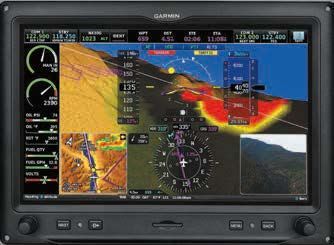In an avionics retrofit world dominated by all-in-one integration, the lowly VHF comm radio generally stands alone. But Garmin, with its new GTR200B VHF comm, blends advanced stereo intercom functions-including Bluetooth connectivity-in one chassis. It can also interface with Garmin’s G3X Touch integrated avionics suite over a CAN (controller area network) bus.
If there’s a downside to the GTR200B radio it might be that it lacks a TSO, which could keep it off-limits for certified aircraft. Here’s a look at its functions and feature set.
Form And Function
The $1395 GTR200B (the B is for Bluetooth) picks up where the first-gen $1199 GTR200 (still available) left off and sports the same chassis and overall footprint. Weighing just shy of two pounds, the radio measures 1.35 inches high by 6.25 inches wide and 9.39 inches deep with the interface connectors in place. That chassis is fairly deep and can pose a challenge for some panels, but it’s slim enough to save space on the face of the panel.
The radio’s LCD display has a 200 by 33 pixel count, which is relatively unimpressive compared to the dazzling color glass displays we’ve grown accustomed to. Still, even with a small 2.95 by .48 inch viewing area and a generous 45-degree side viewing angle, we doubt most users will complain. Think in terms of utility.
The GTR200B’s bezel knobs and buttons have a rugged feel and are unchanged from the GTR200. On the bottom left corner of the bezel is a rotary power knob that serves double-duty as a volume and squelch knob. Yes, the radio has automatic squelch but pushing the knob in puts the circuit in manual squelch mode for added sensitivity.
Speaking of sensitivity, it’s worth mentioning that the radio has a 10-watt transmitter, which should be more than sufficient for transmitting as far as you need it to, provided the antenna system is healthy. Don’t overlook it if replacing an older comm radio, or even when installing it from scratch.
The GTR200B is what we call a smartcomm, with a user interface driven extensively by software. That’s good for a high level of customizing. To get to it, there’s a Menu key for setting user frequencies, entertainment control, telephone interface and a variety of other functions from the menu at the ride side of the display.
The menus are navigated by two softkeys, some of which can be user-defined in the initial setup mode. The menu structure seems shallow enough to not cause extra workload when ham-fisted. But that doesn’t mean the radio doesn’t have a deep user interface. Remember, this is an intercom and VHF radio in one.
But limited To Two
Since nearly every light sport model has two seats, the non-TSO’d GTR200B logically has a two-place intercom. But we wish it supported four stations for more kit-built aircraft.
But where the system lacks in expandability, it excels with standard features. From the softkey menu, you have access to an impressive wireless entertainment interface that’s driven by a Bluetooth smartphone or tablet. The way it ought to be, accessing your tunes on the fly is fast and straightforward. Hit the MED (for media) key for access to the connected smartphone’s Bluetooth media controls. Logically, this is how entertainment audio is piped into the intercom.
And yes, we know there is the argument that music can be a distraction when the workload gets high, and we say selecting the right music might take the edge off for both pilot and passenger. Still, you can turn it off altogether with a dedicated music on/off softkey. That same softkey, when pressed and held, also configures whether the comm radio mutes the intercom entertainment audio.
Further, if you want the other seat on the intercom to have tunes, while you concentrate on the flying, the pilot’s position can be isolated from the entertainment, and also from the intercom.
To start and stop the Bluetooth tunes from flowing, there’s a dedicated Play/Pause control. Press and hold it and you’ll have access to the smartphone or tablet’s media controls and library. You’ll see the artist name, track title, the music volume level and other media playlist data. The Equalizer menu customizes the audio response for rock, classical and pop genres-useful with high-end headsets.
There’s also a full-duplex telephone function, with display of the incoming telephone number. You can answer from the radio, but you have to go into the menu and turn the large rotary knob to highlight Answer, then press the small knob to select it. Do the same to hang up.
Softkeys are also used for more important tasks than dialing in the tunes. The EMR (emergency) softkey quickly tunes up 121.500 MHz, so you don’t have to crank it in with the knob. There’s also a configurable user list for quickly calling up your most-used frequencies.
And so you know precisely what is tuned, the station identifier and type is shown on the screen below the frequency. You can quickly monitor the frequency that’s tuned in standby by pressing the MON key on the upper right area of the bezel, verified with a “M” tag above the STB label. If you’ve flown with the ability to monitor the standby frequency in a single comm radio, you appreciate the utility.
We like the stuck microphone utility for times when the wiring in a control stick (or pilot holding it) goes flaky and keys the transmitter uncommanded. The GTR200B alerts you of a stuck mic-and which position it is-with a “Pilot or Copilot PTT Key Stuck” onscreen message.
3D Audio
As with some Garmin audio panels, the GTR radio has 3D audio. By using different responses in each ear, 3D audio processing creates the illusion that each audio source is coming from a unique location or seat position. You’ll need stereo headsets for the separation to work. During normal operation and with 3D Audio enabled, the listener hears the active frequency at the 12 o’clock position. If the standby is selected for monitoring, the listener hears the active at 11 o’clock and the standby at the 1 o’clock position. Intercom positions are processed to sound like their relative seat location. By default, the GTR 200/200B assumes the pilot sits in the left seat. Pilot seat location can be changed in the configuration mode. We like that you can turn this off in the menu.
Progress
In our view, the GTR200B represents clear progress in VHF radio tech. Combining an intercom and VHF radio in a single unit just makes sense, while simplifying the mechanical installation.
As for installation, without a TSO, STC (or an FAA field approval) the GTR200B is realistically only a player in LSAs and experimentals. For those applications, we think the radio is a solid value.

One reason is that the G3X Touch (and later-model Garmin portables, including the aera660) can, using GPS position, send area-specific frequencies to the comm so you don’t have to look up the frequencies.
While Garmin’s G3X and current G3X Touch suites have built-in VHF comm capability, some basic systems (particularly single-screen versions in more basic aircraft) only have one radio. Adding the GTR200B to this interface adds another, while offering a dedicated control head as backup to the G3X and G3X Touch displays. Of course, adding a second comm radio to the suite means you’ll have to buy an audio panel to switch between the two radios during transmit, and to separate the receiver audio. Moreover, nearly every modern audio panel has a built-in intercom-some with similar features as the GTR200B’s.
Perhaps the interface that makes the most sense is a GTR200B and a compatible Garmin GPS navigator mounted in a panel dock. It’s almost all you need for VFR.


